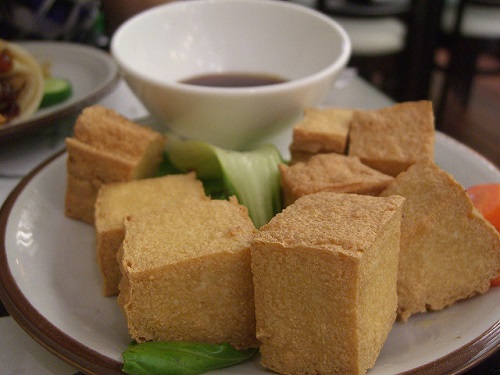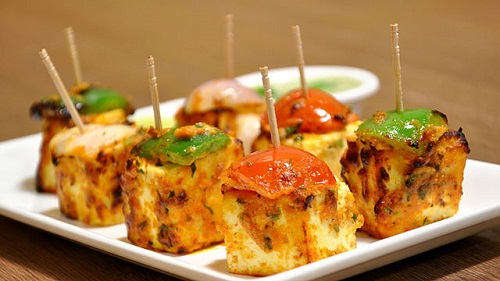Differences Between Tofu and Paneer
Tofu and Paneer are two food products that are consumed in different parts of the world. By appearance, tofu and paneer have a significant number of similarities, which makes people to be confused whether they are consuming tofu or paneer. Besides having ostensible similarities, there are differences between the two products, which will be addressed in this article.
-
What is Tofu?
Tofu is a favorite food product that is obtained from soymilk. It is worth noting that tofu is a versatile food product, which makes it possible to be used in making a significant number of dishes. To produce tofu, coagulation of soymilk and later pressing it into solid blocks results in the formation of tofu. Chinese people have been credited with the invention of this product about 2000 years ago.
-
What is Paneer?
Paneer is a term used to describe the Indian cheese that is made from goat or cow milk. The product is sold when fresh and has unmatched versatility, which makes it be used to prepare or even as a recipe for various dishes, used in India. It is important to note that paneer has significant nutritional benefits, which makes it to at par with other non-vegetarian meals in the market.
Differences Between Tofu and Paneer
-
Origin of the Product
One of the main difference between tofu and paneer is their originality. Tofu is said to have originated from China some 2000 years ago while paneer is said to have originated from the Indian sub-continent. Many personalities around the globe are familiar with tofu because it is available in various outlets as Chinese manufacture and export it to other parts of the world. However, paneer is mostly used in India, which remains to be the place where it originated. Although there are other types of cheese sold in the western countries, they are significantly different from paneer.
-
Health Benefits of Tofu and Paneer
The amounts of benefits obtained from tofu and paneer vary significantly. It is believed that tofu has high health benefits as compared to paneer. One of the main things that make tofu to have more benefits is because it has low calorie and high proteins as compared to paneer. This means that tofu does not add weight to individuals while at the same time ensuring that they are not prone to lifestyle diseases. This is not the same for paneer, which has high calorie and low protein content hence exposing people to increased weight, which can result in lifestyle diseases.
-
Original Product/Raw Material
The other difference that exists between tofu and paneer is that the two products are produced from different raw materials. Paneer is predominantly produced from goat or cow milk while tofu can be produced from soybean despite it being produced from coagulated milk. This explains why tofu is sometimes referred to as bean curd or soy curd. It can also be used as an argument to justify why tofu has a low-calorie count and higher protein content. Moreover, soybeans have been proven rich in proteins than milk.
-
Fat Content in Tofu and Paneer
Fat content between tofu and paneer forms a significant difference, which is used by many people to decide on what to buy. Paneer has high-fat content while tofu has low-fat content. One of the main aspects that make paneer to have high-fat content is the fact that it is obtained from milk, which has a significant amount of fat while tofu is obtained from coagulated milk, which sometimes may not have large amounts of fat molecules. In addition, tofu can sometimes be derived from cereals like soybeans, which are known to have low-fat content. This explains why people who intend to reduce fat intake choose to consume tofu instead of paneer.
-
Perishability/State of selling
Perishability and the state in which both tofu and paneer are sold offer a point of difference worth to note. Paneer is highly perishable because it is made from fresh milk while tofu can wait for a significant period without going bad because it is made from coagulated milk. Besides, perishability of paneer makes it be sold only when fresh after which it will not be suitable for human consumption. On the other hand, tofu can be sold while fresh or even after processing. It is also important to note that one can stock tofu for a more extended period while stocking paneer is not recommended unless one has a refrigerator to cool paneer cubes.
-
Taste and Texture of Tofu and Paneer
The physical aspects of paneer and tofu tend to vary which makes it possible for people to distinguish between the two products with ease. Tofu has a sour taste because it is formed by coagulation of milk. Furthermore, it is worth noting that tofu has some thick texture and slightly solid particles, especially the one extracted from soybeans. On the other hand, it is meriting that paneer has a sour to bitter taste because it is prepared by curdling mild with food acid like lemon juice and vinegar among others. It is also worth noting that paneer has a fine texture.
Table Showing Differences Between Paneer and Tofu
|
|
Paneer |
Tofu |
| Origin | Indian Sub-continent | China |
| Health Benefits | Low Calorie and High Protein | High Calorie and High Protein |
| Raw Material | Goat and Cow Milk | Coagulated Milk and Soybeans |
| Fat Content | High-Fat Content | Low-Fat Content |
| State of Selling | Sold Fresh | Sold Fresh and Processed |
| Perishability | Highly Perishable | Low Perishability Levels |
Summary of Tofu and Paneer
- Despite paneer and tofu having differences, they are both nutritious products that ought to be consumed by people so that they can enhance their general body wellness.
- Several research studies on the nutritional composition of tofu and the Indian cheese have indicated that both products are rich in protein, iron, calcium, fatty acids, and magnesium among other nutrients that are essential in our bodies.
- However, it is crucial to differentiate tofu from paneer by use of taste and texture, fat content, health benefits, and nutritional composition because both products have different benefits in our bodies and it is essential that one selects what will work for his or her own body.
- Difference Between Gross NPA and Net NPA - April 20, 2018
- Difference Between Job Description and Job Specification - April 13, 2018
- Difference Between Yoga and Power Yoga - April 10, 2018
Search DifferenceBetween.net :
Leave a Response
References :
[0]Mathur, B., et al. "Traditional cheese" Paneer" in India and soybean food" tofu" in Japan." Japanese Journal of Dairy and Food Science (Japan) (1986).
[1]Mathur, B., et al. "Traditional cheese" Paneer" in India and soybean food" tofu" in Japan." Japanese Journal of Dairy and Food Science (Japan) (1986).
[2]Pant, A. L. O. K., et al. "Texture profile analysis of tofu and milk paneer before and after deep fat frying." Journal of Food Science and Technology (India) (1993).
[3]Raja, Jeelani, Hillal A. Punoo, and Farooq A. Masoodi. "Comparative study of soy paneer prepared from soymilk, blends of soymilk and skimmed milk." Journal of Food Processing & Technology 5.2 (2014): 1.
[4]"Image Credit: https://www.flickr.com/photos/avlxyz/2231948773"
[5]"Image Credit: https://commons.wikimedia.org/wiki/File:Paneer_Shashlik.JPG"


